Deck 19: Stellar Evolution: on and After the Main Sequence
Question
Question
Question
Question
Question
Question
Question
Question
Question
Question
Question
Question
Question
Question
Question
Question
Question
Question
Question
Question
Question
Question
Question
Question
Question
Question
Question
Question
Question
Question
Question
Question
Question
Question
Question
Question
Question
Question
Question
Question
Question
Question
Question
Question
Question
Question
Question
Question
Question
Question
Question
Question
Question
Question
Question
Question
Question
Question
Question
Question
Question
Question
Question
Question

Unlock Deck
Sign up to unlock the cards in this deck!
Unlock Deck
Unlock Deck
1/64
Play
Full screen (f)
Deck 19: Stellar Evolution: on and After the Main Sequence
1
If you were to select a star at random within the Milky Way Galaxy, chances are very great that it would be a:
A)red giant.
B)red dwarf.
C)white dwarf.
D)solar G-type main-sequence star.
A)red giant.
B)red dwarf.
C)white dwarf.
D)solar G-type main-sequence star.
B
2
What particular feature of stellar behavior is associated with the fact that a star is on the main sequence in the Hertzsprung-Russell diagram?
A)The star is generating internal energy by hydrogen fusion in its core.
B)The star is slowly shrinking, thereby releasing gravitational potential energy.
C)The star is generating energy by helium fusion in its core, having stopped hydrogen "burning."
D)The star has ceased nuclear "burning" and is simply cooling down by emitting radiation.
A)The star is generating internal energy by hydrogen fusion in its core.
B)The star is slowly shrinking, thereby releasing gravitational potential energy.
C)The star is generating energy by helium fusion in its core, having stopped hydrogen "burning."
D)The star has ceased nuclear "burning" and is simply cooling down by emitting radiation.
A
3
When a protostar evolves to the point where it begins steady hydrogen fusion in its core and first achieves hydrostatic equilibrium, it is called:
A)a first-form main-sequence star.
B)a zero-age main-sequence star.
C)a T Tauri star.
D)a proplyd.
A)a first-form main-sequence star.
B)a zero-age main-sequence star.
C)a T Tauri star.
D)a proplyd.
B
4
What is the minimum mass necessary in a protostar for it to begin nuclear reactions and become a main sequence star?
A)0.08 M ?
B)0.4 M ?
C)1.0 M ?
D)1.4 M ?
A)0.08 M ?
B)0.4 M ?
C)1.0 M ?
D)1.4 M ?

Unlock Deck
Unlock for access to all 64 flashcards in this deck.
Unlock Deck
k this deck
5
Which group of stars in the H-R diagram would be labeled "zero-age main sequence"?
A)stars that have just collapsed from the interstellar medium
B)stars that are just beginning to convert helium into carbon in their cores
C)stars that contain no processed elements (elements heavier than hydrogen or helium)
D)stars that have just started converting hydrogen to helium in their cores
A)stars that have just collapsed from the interstellar medium
B)stars that are just beginning to convert helium into carbon in their cores
C)stars that contain no processed elements (elements heavier than hydrogen or helium)
D)stars that have just started converting hydrogen to helium in their cores

Unlock Deck
Unlock for access to all 64 flashcards in this deck.
Unlock Deck
k this deck
6
If you were to look at 1 kg of material taken from the surface of the Sun and 1 kg taken from the center, which of the following statements would be true of these two 1-kg masses?
A)The kilogram from the surface would contain more hydrogen than the one from the center.
B)Neither of them would contain any hydrogen.
C)They both would contain the same amount of hydrogen.
D)The kilogram from the surface would contain less hydrogen than the one from the center.
A)The kilogram from the surface would contain more hydrogen than the one from the center.
B)Neither of them would contain any hydrogen.
C)They both would contain the same amount of hydrogen.
D)The kilogram from the surface would contain less hydrogen than the one from the center.

Unlock Deck
Unlock for access to all 64 flashcards in this deck.
Unlock Deck
k this deck
7
For a main-sequence star of less than 0.4 M ? , what percentage of the mass of the core still remains as hydrogen after the thermonuclear furnace has transformed hydrogen into helium over its main-sequence lifetime?
A)75%
B)35%
C)25%
D)less than 1%
A)75%
B)35%
C)25%
D)less than 1%

Unlock Deck
Unlock for access to all 64 flashcards in this deck.
Unlock Deck
k this deck
8
What causes the core of a star to contract during the main-sequence phase of the star's life?
A)The conversion of hydrogen into helium reduces the number of particles in the core.
B)Convection in the outer layers carries energy out of the core more efficiently as the star ages.
C)Helium has a larger atomic weight than hydrogen and exerts a stronger gravitational pull on the core.
D)The rate of core hydrogen burning decreases as the hydrogen is used up, reducing the rate of energy generation.
A)The conversion of hydrogen into helium reduces the number of particles in the core.
B)Convection in the outer layers carries energy out of the core more efficiently as the star ages.
C)Helium has a larger atomic weight than hydrogen and exerts a stronger gravitational pull on the core.
D)The rate of core hydrogen burning decreases as the hydrogen is used up, reducing the rate of energy generation.

Unlock Deck
Unlock for access to all 64 flashcards in this deck.
Unlock Deck
k this deck
9
What is the most important quantity on which the lifetime of a star depends?
A)temperature of the star's corona
B)abundance of heavy elements in the star
C)star's speed of rotation
D)mass of the star
A)temperature of the star's corona
B)abundance of heavy elements in the star
C)star's speed of rotation
D)mass of the star

Unlock Deck
Unlock for access to all 64 flashcards in this deck.
Unlock Deck
k this deck
10
A main-sequence star has a certain lifetime, t, because of thermonuclear "burning" of the hydrogen in the core of the star. How is this lifetime on the main sequence related to the mass M and luminosity L of the star? ( means "proportional to")
A)t M/L
B)t ML
C)t L/M
D)t M3.5
A)t M/L
B)t ML
C)t L/M
D)t M3.5

Unlock Deck
Unlock for access to all 64 flashcards in this deck.
Unlock Deck
k this deck
11
If you examine many main-sequence stars, the lifetimes are different. As the mass of the star under consideration increases, the star's main-sequence lifetime:
A)is unaffected, as lifetime depends only on temperature and luminosity and not mass.
B)increases because the star has more fuel to burn.
C)increases because more massive stars have cooler surfaces and smaller luminosities.
D)decreases because larger stars consume their fuel at a larger rate.
A)is unaffected, as lifetime depends only on temperature and luminosity and not mass.
B)increases because the star has more fuel to burn.
C)increases because more massive stars have cooler surfaces and smaller luminosities.
D)decreases because larger stars consume their fuel at a larger rate.

Unlock Deck
Unlock for access to all 64 flashcards in this deck.
Unlock Deck
k this deck
12
If you examine many main-sequence stars, the lifetimes are different. As the luminosity of the star under consideration increases, the star's main-sequence lifetime:
A)is unaffected, as lifetime depends only on temperature and mass and not luminosity.
B)decreases because the star's fuel is being expended at a larger rate.
C)increases because larger luminosities imply larger masses.
D)decreases because larger luminosities go with smaller, hotter stars.
A)is unaffected, as lifetime depends only on temperature and mass and not luminosity.
B)decreases because the star's fuel is being expended at a larger rate.
C)increases because larger luminosities imply larger masses.
D)decreases because larger luminosities go with smaller, hotter stars.

Unlock Deck
Unlock for access to all 64 flashcards in this deck.
Unlock Deck
k this deck
13
What is the expected main-sequence lifetime of a star with a mass of 15 M ? ? (See Table 19-1 of Universe, 11th ed.)
?
 ?
?
A)10 billion years
B)less than 1 million years
C)3 million years
D)15 million years
?
 ?
?A)10 billion years
B)less than 1 million years
C)3 million years
D)15 million years

Unlock Deck
Unlock for access to all 64 flashcards in this deck.
Unlock Deck
k this deck
14
How long will a star whose mass is 0.75 the mass of the Sun stay on the main sequence? (See Table 19-1 of Universe, 11th ed.)
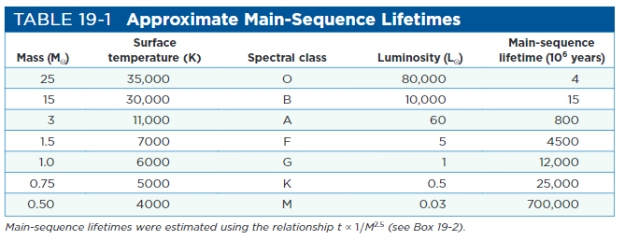
A)25 billion years
B)3 million years
C)500 million years
D)10 billion years

A)25 billion years
B)3 million years
C)500 million years
D)10 billion years

Unlock Deck
Unlock for access to all 64 flashcards in this deck.
Unlock Deck
k this deck
15
How long is the main-sequence lifetime of a star with 3 times the Sun's mass compared to the lifetime of the Sun? (See Table 19-1 of Universe, 11th ed.)
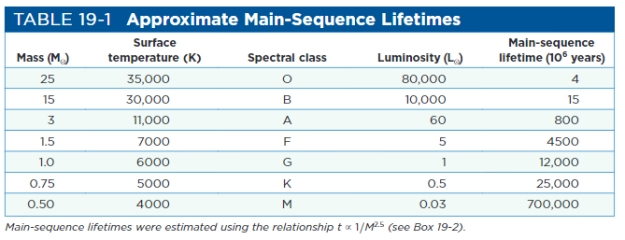
A)about 3 times as long
B)about 1/500 as long
C)about 1/15 as long
D)about 1/3 as long

A)about 3 times as long
B)about 1/500 as long
C)about 1/15 as long
D)about 1/3 as long

Unlock Deck
Unlock for access to all 64 flashcards in this deck.
Unlock Deck
k this deck
16
The star ? Pegasi (in the constellation Pegasus, the Flying Horse) has a spectral luminosity class of B8 V, giving it a surface temperature of about 12,000 K. According to Table 19-1 of Universe, 11th ed., the expected main-sequence lifetime of ? Pegasi is:
?
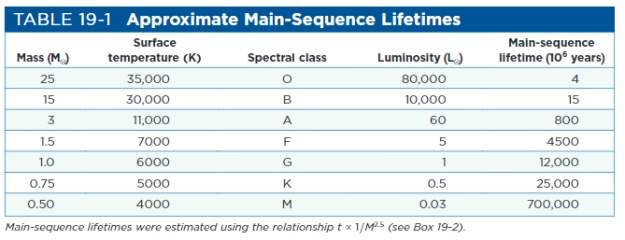 ?
?
A)about 400,000 years.
B)about 400 million years.
C)much greater than 800 million years.
D)not defined in any way by the above information.
?
 ?
?A)about 400,000 years.
B)about 400 million years.
C)much greater than 800 million years.
D)not defined in any way by the above information.

Unlock Deck
Unlock for access to all 64 flashcards in this deck.
Unlock Deck
k this deck
17
The end product of a red dwarf is believed to be a star of pure helium. How do we know this?
A)We are watching the evolution of red dwarfs in our galaxy. Some of those are very near the end of their main-sequence life cycle, and they are essentially pure helium.
B)There are many pure helium stars in our galaxy, and these are presumed to come from red dwarfs.
C)There are no pure helium stars around, but there are later generations of stars that must have evolved from stars of pure helium.
D)The lifetimes of red dwarfs are too long for any of them to have completed their evolution, but we have theoretical models.
A)We are watching the evolution of red dwarfs in our galaxy. Some of those are very near the end of their main-sequence life cycle, and they are essentially pure helium.
B)There are many pure helium stars in our galaxy, and these are presumed to come from red dwarfs.
C)There are no pure helium stars around, but there are later generations of stars that must have evolved from stars of pure helium.
D)The lifetimes of red dwarfs are too long for any of them to have completed their evolution, but we have theoretical models.

Unlock Deck
Unlock for access to all 64 flashcards in this deck.
Unlock Deck
k this deck
18
If you were able to return to Earth 1 million years into the future, which of the following views of the sky would be most likely?
A)All the present stars, both blue and red, would be visible, but nearby stars would have moved in position.
B)The sky would be very much as it is now, because 1 million years is a very short time in astronomical terms.
C)Nearby stars would have moved in position, and many blue stars presently visible would no longer be visible.
D)A few red stars would be missing because they would have evolved, but stars would be the same and in the same positions as today.
A)All the present stars, both blue and red, would be visible, but nearby stars would have moved in position.
B)The sky would be very much as it is now, because 1 million years is a very short time in astronomical terms.
C)Nearby stars would have moved in position, and many blue stars presently visible would no longer be visible.
D)A few red stars would be missing because they would have evolved, but stars would be the same and in the same positions as today.

Unlock Deck
Unlock for access to all 64 flashcards in this deck.
Unlock Deck
k this deck
19
The spiral galaxy in which we live is roughly 14 billion years old. For the stars that formed when the galaxy was very young (say, during the first billion years), which of the following statements is true? (See Table 19-1 of Universe, 11th ed.)
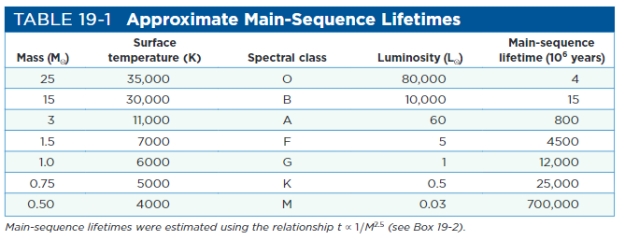
A)Some stars of half the mass of the Sun are still on the main sequence, but most have finished their lives as stars.
B)All stars of half the mass of the Sun are still on the main sequence.
C)Some stars of 15 times the mass of the Sun are still on the main sequence, but most have finished their lives as stars.
D)All stars of 3 times the mass of the Sun are still on the main sequence.

A)Some stars of half the mass of the Sun are still on the main sequence, but most have finished their lives as stars.
B)All stars of half the mass of the Sun are still on the main sequence.
C)Some stars of 15 times the mass of the Sun are still on the main sequence, but most have finished their lives as stars.
D)All stars of 3 times the mass of the Sun are still on the main sequence.

Unlock Deck
Unlock for access to all 64 flashcards in this deck.
Unlock Deck
k this deck
20
In the approximately 5 billion years since the Sun began its main-sequence phase, its radius has increased by 6% and its surface temperature has increased by 5%. How has its luminosity changed?
A)decreased by 10%
B)decreased by 5%
C)increased by 5%
D)increased by 40%
A)decreased by 10%
B)decreased by 5%
C)increased by 5%
D)increased by 40%

Unlock Deck
Unlock for access to all 64 flashcards in this deck.
Unlock Deck
k this deck
21
Immediately following the end of core hydrogen fusion, continued energy flow from the core is created by:
A)helium fusion.
B)the Kelvin-Helmholtz contraction.
C)radioactivity.
D)the fusion of carbon, oxygen, and other heavier nuclei.
A)helium fusion.
B)the Kelvin-Helmholtz contraction.
C)radioactivity.
D)the fusion of carbon, oxygen, and other heavier nuclei.

Unlock Deck
Unlock for access to all 64 flashcards in this deck.
Unlock Deck
k this deck
22
Within the deep interior of the Sun, which development will eventually lead to major changes as the Sun evolves off the main sequence toward the red giant phase of its life?
A)expansion of the core by the buildup of hydrogen in the nuclear furnace, pushing the outer regions of the Sun outward
B)the supernova explosion that will occur when the buildup of helium in the core exceeds a certain critical amount
C)slowing down of the nuclear furnace as the central core temperature drops with time
D)buildup of inactive helium by the transformation of hydrogen in the thermonuclear furnace
A)expansion of the core by the buildup of hydrogen in the nuclear furnace, pushing the outer regions of the Sun outward
B)the supernova explosion that will occur when the buildup of helium in the core exceeds a certain critical amount
C)slowing down of the nuclear furnace as the central core temperature drops with time
D)buildup of inactive helium by the transformation of hydrogen in the thermonuclear furnace

Unlock Deck
Unlock for access to all 64 flashcards in this deck.
Unlock Deck
k this deck
23
Approximately what fraction of the Sun's main-sequence lifetime has been completed at the present time? (See Table 19-1 of Universe, 11th ed.)
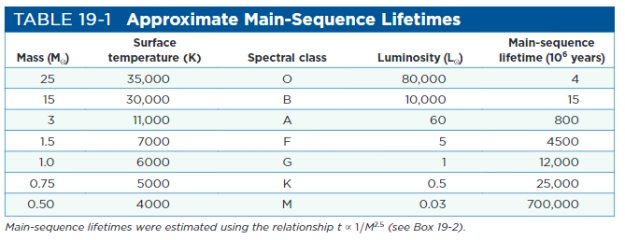
A)less than 10%
B)about 3/4
C)about 1/4
D)about 1/2

A)less than 10%
B)about 3/4
C)about 1/4
D)about 1/2

Unlock Deck
Unlock for access to all 64 flashcards in this deck.
Unlock Deck
k this deck
24
What rates of mass loss are typical from red giant stars?
A)10-3 M ? per year
B)Red giant stars do not suffer mass loss.
C)1 M ? per year
D)10-7 M ? per year
A)10-3 M ? per year
B)Red giant stars do not suffer mass loss.
C)1 M ? per year
D)10-7 M ? per year

Unlock Deck
Unlock for access to all 64 flashcards in this deck.
Unlock Deck
k this deck
25
The Kelvin-Helmholtz contraction supplies significant energy to a star:
A)only in the stages before the main sequence.
B)after the core of a late main-sequence star runs out of hydrogen.
C)all during the main-sequence lifetime of star.
D)only when the outer edges of the star collapse inward.
A)only in the stages before the main sequence.
B)after the core of a late main-sequence star runs out of hydrogen.
C)all during the main-sequence lifetime of star.
D)only when the outer edges of the star collapse inward.

Unlock Deck
Unlock for access to all 64 flashcards in this deck.
Unlock Deck
k this deck
26
When the Sun first becomes a red giant star, its energy generation will be produced by:
A)core hydrogen fusion.
B)shell hydrogen fusion.
C)core helium fusion.
D)Kelvin-Helmholtz contraction.
A)core hydrogen fusion.
B)shell hydrogen fusion.
C)core helium fusion.
D)Kelvin-Helmholtz contraction.

Unlock Deck
Unlock for access to all 64 flashcards in this deck.
Unlock Deck
k this deck
27
The majority of the elements heavier than hydrogen and helium in the universe are believed to have originated in:
A)the original Big Bang.
B)the central cores of stars.
C)HII regions, under the action of H light.
D)giant molecular clouds.
A)the original Big Bang.
B)the central cores of stars.
C)HII regions, under the action of H light.
D)giant molecular clouds.

Unlock Deck
Unlock for access to all 64 flashcards in this deck.
Unlock Deck
k this deck
28
Helium fusion begins in the core of a low-mass star after the helium flash. Where did this helium come from?
A)It was part of the original protostar, but before the helium flash, the temperature was not high enough for helium fusion.
B)It was produced by hydrogen fusion during the main-sequence phase.
C)The star acquired it from meteor and comet impacts during the main-sequence phase.
D)It was produced by the helium flash.
A)It was part of the original protostar, but before the helium flash, the temperature was not high enough for helium fusion.
B)It was produced by hydrogen fusion during the main-sequence phase.
C)The star acquired it from meteor and comet impacts during the main-sequence phase.
D)It was produced by the helium flash.

Unlock Deck
Unlock for access to all 64 flashcards in this deck.
Unlock Deck
k this deck
29
The core hydrogen fusion phase will span approximately 12 billion years for a star like the Sun. How long will the core helium fusion phase last?
A)12 billion years
B)1 billion years
C)100 million years
D)1 million years
A)12 billion years
B)1 billion years
C)100 million years
D)1 million years

Unlock Deck
Unlock for access to all 64 flashcards in this deck.
Unlock Deck
k this deck
30
After the helium flash in a low-mass star, the star experiences hydrogen burning in a shell around the core. While on the main sequence, this star burned hydrogen in its core and WHAT in the shell around its core?
A)hydrogen
B)protons
C)carbon
D)There is no shell burning for main-sequence stars.
A)hydrogen
B)protons
C)carbon
D)There is no shell burning for main-sequence stars.

Unlock Deck
Unlock for access to all 64 flashcards in this deck.
Unlock Deck
k this deck
31
During helium burning, some 4He combines with 16O, similar the way in which it combines with 12C to form 16O. What is produced by the 16O + 4He reaction? (The periodic table shown in Box 5-5 of Universe, 11th ed., may be useful.)
A)22Na (light isotope of sodium)
B)20Ne (regular isotope of neon)
C)18O (heavy isotope of oxygen)
D)24Mg (regular isotope of magnesium)
A)22Na (light isotope of sodium)
B)20Ne (regular isotope of neon)
C)18O (heavy isotope of oxygen)
D)24Mg (regular isotope of magnesium)

Unlock Deck
Unlock for access to all 64 flashcards in this deck.
Unlock Deck
k this deck
32
The Pauli exclusion principle, describing the quantum states of particles, stipulates that no two identical particles (such as electrons) can:
A)have the same speed.
B)have the same position in space.
C)have the same electrical charge.
D)be in the same quantum state.
A)have the same speed.
B)have the same position in space.
C)have the same electrical charge.
D)be in the same quantum state.

Unlock Deck
Unlock for access to all 64 flashcards in this deck.
Unlock Deck
k this deck
33
Electron degeneracy, a result of the Pauli exclusion principle that prevents electrons from becoming crowded together beyond a certain limit, is important in:
A)the core of a low-mass star just before the start of core helium burning.
B)the core of a low-mass star just before the start of core hydrogen burning.
C)the core of a low-mass star during core hydrogen burning.
D)a low-mass protostar evolving toward the main sequence.
A)the core of a low-mass star just before the start of core helium burning.
B)the core of a low-mass star just before the start of core hydrogen burning.
C)the core of a low-mass star during core hydrogen burning.
D)a low-mass protostar evolving toward the main sequence.

Unlock Deck
Unlock for access to all 64 flashcards in this deck.
Unlock Deck
k this deck
34
A helium flash occurs in the cores of all stars:
A)that contain helium.
B)of more than 2 M ?
C)of fewer than 2 M ?
D)that have become red giants.
A)that contain helium.
B)of more than 2 M ?
C)of fewer than 2 M ?
D)that have become red giants.

Unlock Deck
Unlock for access to all 64 flashcards in this deck.
Unlock Deck
k this deck
35
After the helium flash in a red giant star, the star contracts because:
A)energy radiated to space during the helium flash cools the entire star, making it contract.
B)the electrons in the core become degenerate during the helium flash, reducing the volume occupied by the core.
C)the helium flash uses most of the helium in the star's core, reducing the energy produced in the core.
D)the star's deep interior expands and cools during the helium flash, reducing the energy produced by the hydrogen burning shell.
A)energy radiated to space during the helium flash cools the entire star, making it contract.
B)the electrons in the core become degenerate during the helium flash, reducing the volume occupied by the core.
C)the helium flash uses most of the helium in the star's core, reducing the energy produced in the core.
D)the star's deep interior expands and cools during the helium flash, reducing the energy produced by the hydrogen burning shell.

Unlock Deck
Unlock for access to all 64 flashcards in this deck.
Unlock Deck
k this deck
36
Which way does a star of about 1 M ? evolve, on the Hertzsprung-Russell diagram, at the end of its main-sequence lifetime?
A)toward lower luminosity and higher temperature-progressing through the main sequence toward the white dwarf stage
B)toward higher luminosity and lower temperature-away from the main sequence
C)toward higher luminosity and higher temperature-upward along the main sequence
D)toward lower luminosity and temperature-downward along the main sequence
A)toward lower luminosity and higher temperature-progressing through the main sequence toward the white dwarf stage
B)toward higher luminosity and lower temperature-away from the main sequence
C)toward higher luminosity and higher temperature-upward along the main sequence
D)toward lower luminosity and temperature-downward along the main sequence

Unlock Deck
Unlock for access to all 64 flashcards in this deck.
Unlock Deck
k this deck
37
In the H-R diagram in Figure 19-15 of Universe, 11th ed., the brightest stars in the Pleiades cluster are not on the main sequence but toward the upper right. Why is this?
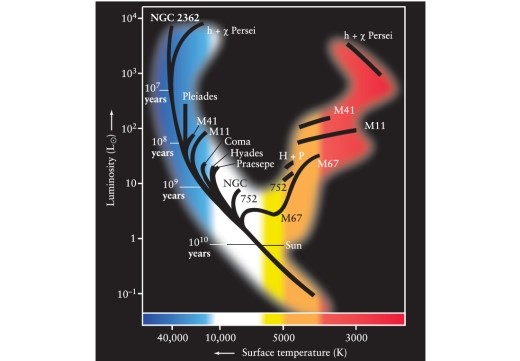
A)These stars have not yet reached the main sequence and are in the T Tauri phase.
B)These stars have already evolved through the red giant phase, returned to the blue giant phase and are on their way to the white dwarf phase.
C)These stars have already become white dwarf stars, as shown by their position.
D)These blue supergiant stars have already begun to evolve toward the red supergiant phase.

A)These stars have not yet reached the main sequence and are in the T Tauri phase.
B)These stars have already evolved through the red giant phase, returned to the blue giant phase and are on their way to the white dwarf phase.
C)These stars have already become white dwarf stars, as shown by their position.
D)These blue supergiant stars have already begun to evolve toward the red supergiant phase.

Unlock Deck
Unlock for access to all 64 flashcards in this deck.
Unlock Deck
k this deck
38
Figure 19-11 of Universe, 11th ed., shows the evolution of a hypothetical open cluster. Is there a time when the most massive stars have become red giants and the least massive stars have not yet reached the main sequence?

A)No, the protostar phase is so short compared to the main-sequence phase that all protostars have reached the main sequence long before any evolve off it.
B)No, the main-sequence phase is the longest, even for more massive stars, and all stars remain a great while on the main sequence before beginning evolution to red giants.
C)Yes, after about 30 million years for this cluster, there are both red giants and protostars.
D)Yes, after 1 billion years the least massive protostars have not yet reached the main sequence, while a few massive main-sequence stars have evolved to become red giants.

A)No, the protostar phase is so short compared to the main-sequence phase that all protostars have reached the main sequence long before any evolve off it.
B)No, the main-sequence phase is the longest, even for more massive stars, and all stars remain a great while on the main sequence before beginning evolution to red giants.
C)Yes, after about 30 million years for this cluster, there are both red giants and protostars.
D)Yes, after 1 billion years the least massive protostars have not yet reached the main sequence, while a few massive main-sequence stars have evolved to become red giants.

Unlock Deck
Unlock for access to all 64 flashcards in this deck.
Unlock Deck
k this deck
39
On the Hertzsprung-Russell diagram, in which direction does the position occupied by a star move after hydrogen burning ends in the star's core?
A)toward the upper left
B)toward the lower left
C)toward the lower right
D)toward the upper right
A)toward the upper left
B)toward the lower left
C)toward the lower right
D)toward the upper right

Unlock Deck
Unlock for access to all 64 flashcards in this deck.
Unlock Deck
k this deck
40
A globular cluster is a group of stars that has:
A)many thousands of members, mostly binary, of different ages.
B)many thousands of members, all very old, with very few elements heavier than helium.
C)many thousands of members of different ages but with the same chemical composition.
D)a few hundred members, often still embedded in the gas from which they were formed.
A)many thousands of members, mostly binary, of different ages.
B)many thousands of members, all very old, with very few elements heavier than helium.
C)many thousands of members of different ages but with the same chemical composition.
D)a few hundred members, often still embedded in the gas from which they were formed.

Unlock Deck
Unlock for access to all 64 flashcards in this deck.
Unlock Deck
k this deck
41
Which of the following statements is NOT TRUE of a globular cluster?
A)It contains significant amounts of dust and gas surrounding the stars.
B)It has a round shape.
C)It can contain up to a million stars.
D)It contains only low-mass stars.
A)It contains significant amounts of dust and gas surrounding the stars.
B)It has a round shape.
C)It can contain up to a million stars.
D)It contains only low-mass stars.

Unlock Deck
Unlock for access to all 64 flashcards in this deck.
Unlock Deck
k this deck
42
Which of the following statements is NOT TRUE of a globular cluster?
A)It does not contain main-sequence stars.
B)It can contain up to a million stars.
C)It has a round shape.
D)It contains only low-mass stars.
A)It does not contain main-sequence stars.
B)It can contain up to a million stars.
C)It has a round shape.
D)It contains only low-mass stars.

Unlock Deck
Unlock for access to all 64 flashcards in this deck.
Unlock Deck
k this deck
43
An astronomer studying a globular cluster plots its stars on a Hertzsprung-Russell diagram and finds that certain stars in the cluster lie on the horizontal branch. What does this astronomer immediately know about these stars?
A)They are still contracting toward the main sequence.
B)They are burning hydrogen into helium in their cores.
C)They are burning helium into carbon and oxygen in their cores.
D)They are burning helium into carbon and oxygen in a shell around their cores.
A)They are still contracting toward the main sequence.
B)They are burning hydrogen into helium in their cores.
C)They are burning helium into carbon and oxygen in their cores.
D)They are burning helium into carbon and oxygen in a shell around their cores.

Unlock Deck
Unlock for access to all 64 flashcards in this deck.
Unlock Deck
k this deck
44
The "turnoff" point for a star cluster is the point in the H-R diagram occupied by the:
A)highest-mass main-sequence stars in the cluster.
B)stars undergoing (or about to undergo) the helium flash.
C)lowest-mass main-sequence stars in the cluster.
D)highest-mass stars that have not yet reached the main sequence.
A)highest-mass main-sequence stars in the cluster.
B)stars undergoing (or about to undergo) the helium flash.
C)lowest-mass main-sequence stars in the cluster.
D)highest-mass stars that have not yet reached the main sequence.

Unlock Deck
Unlock for access to all 64 flashcards in this deck.
Unlock Deck
k this deck
45
Suppose that, when the stars in a particular open star cluster are plotted in an H-R diagram, the luminosity of stars at the turnoff point is about 5 times the luminosity of the Sun. Approximately what is the age of this cluster? (See Figure 19-15 of Universe, 11th ed.)
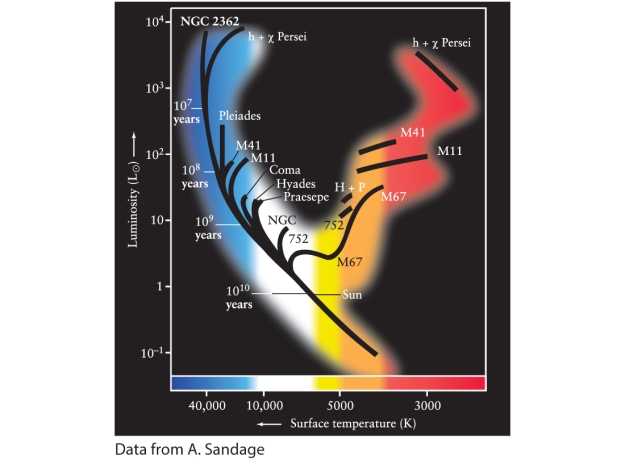
A)100 million years
B)1 billion years
C)500 million years
D)4 billion years

A)100 million years
B)1 billion years
C)500 million years
D)4 billion years

Unlock Deck
Unlock for access to all 64 flashcards in this deck.
Unlock Deck
k this deck
46
The stars at the turnoff point in the H-R diagram of the Hyades star cluster have an absolute magnitude of approximately M = +2, whereas those at the turnoff point in the cluster M41 have M = 0. From this information, we can say with certainty that the Hyades cluster:
A)is farther away than M41.
B)older than M41.
C)has more stars in it than M41.
D)younger than M41.
A)is farther away than M41.
B)older than M41.
C)has more stars in it than M41.
D)younger than M41.

Unlock Deck
Unlock for access to all 64 flashcards in this deck.
Unlock Deck
k this deck
47
Suppose you pick 100 stars at random from the night sky and plot the apparent magnitude versus color ratio for these stars. What would this plot show you?
A)This is a color-magnitude diagram. By noting the turnoff point on the main sequence you could determine the age of the oldest star in the group.
B)Because we are not examining stars in a cluster, there will be no turnoff point. But you will have an H-R diagram with main sequence, giants, and white dwarves.
C)Because we are not examining stars in a cluster, there will be no turnoff point. It will be an H-R diagram, but with only 100 stars it is unlikely that more than one or two stars will be red giants.
D)Because we are plotting apparent magnitude versus color ratio for a group of unrelated stars, the plot will probably not show any particular pattern.
A)This is a color-magnitude diagram. By noting the turnoff point on the main sequence you could determine the age of the oldest star in the group.
B)Because we are not examining stars in a cluster, there will be no turnoff point. But you will have an H-R diagram with main sequence, giants, and white dwarves.
C)Because we are not examining stars in a cluster, there will be no turnoff point. It will be an H-R diagram, but with only 100 stars it is unlikely that more than one or two stars will be red giants.
D)Because we are plotting apparent magnitude versus color ratio for a group of unrelated stars, the plot will probably not show any particular pattern.

Unlock Deck
Unlock for access to all 64 flashcards in this deck.
Unlock Deck
k this deck
48
When the stars of the following open clusters are plotted on an H-R diagram, the luminosity values for the turning points are approximately (in solar luminosities): Coma (7), h + (600), M67 (2), and Pleiades (70). Which cluster is youngest?
A)Coma
B)h +
C)M67
D)Pleiades
A)Coma
B)h +
C)M67
D)Pleiades

Unlock Deck
Unlock for access to all 64 flashcards in this deck.
Unlock Deck
k this deck
49
When the stars of the following open clusters are plotted on an H-R diagram, the temperature values for the turning points are approximately: Coma (10,000 K), h + (40,000 K), M67 (7500 K), and Pleiades (20,000 K). Which cluster is oldest?
A)Coma
B)h +
C)M67
D)Pleiades
A)Coma
B)h +
C)M67
D)Pleiades

Unlock Deck
Unlock for access to all 64 flashcards in this deck.
Unlock Deck
k this deck
50
When the stars of the following open clusters are plotted on an H-R diagram, the absolute magnitude values for the turning points are approximately: Coma (2.4), h + (-2), M67 (4.5), and Pleiades (0.3). Which cluster is youngest?
A)Coma
B)h +
C)M67
D)Pleiades
A)Coma
B)h +
C)M67
D)Pleiades

Unlock Deck
Unlock for access to all 64 flashcards in this deck.
Unlock Deck
k this deck
51
The H-R diagram for open star clusters (See Figure 19-15 of Universe, 11th ed.) shows the Sun at approximately the 10-billion-year mark on the main sequence. What is the meaning of this?
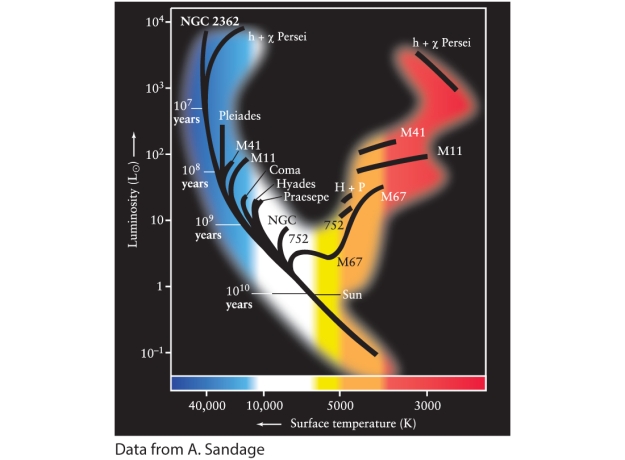
A)The present age of the Sun is approximately 10 billion years.
B)The Sun will change its position very little on the diagram during the rest of its main sequence lifetime and thus will still be near the 10-billion-year mark when it finishes its hydrogen burning.
C)The Sun will evolve a considerable distance up the main sequence, toward higher luminosities, before it leaves the main sequence.
D)The Sun will evolve a considerable distance down the main sequence, toward lower luminosities, before it leaves the main sequence.

A)The present age of the Sun is approximately 10 billion years.
B)The Sun will change its position very little on the diagram during the rest of its main sequence lifetime and thus will still be near the 10-billion-year mark when it finishes its hydrogen burning.
C)The Sun will evolve a considerable distance up the main sequence, toward higher luminosities, before it leaves the main sequence.
D)The Sun will evolve a considerable distance down the main sequence, toward lower luminosities, before it leaves the main sequence.

Unlock Deck
Unlock for access to all 64 flashcards in this deck.
Unlock Deck
k this deck
52
Where on the H-R diagram would you expect to find Population I and II stars?
A)Each population should be scattered throughout the entire diagram.
B)Population I stars are restricted to the left (high temperature) side of the diagram, and Population II stars are to the right side.
C)Population I stars are restricted to the right (low temperature) side of the diagram, and Population II stars are to the left side.
D)Population I stars are represented across the entire H-R diagram, but Population II stars exist primarily on the right side.
A)Each population should be scattered throughout the entire diagram.
B)Population I stars are restricted to the left (high temperature) side of the diagram, and Population II stars are to the right side.
C)Population I stars are restricted to the right (low temperature) side of the diagram, and Population II stars are to the left side.
D)Population I stars are represented across the entire H-R diagram, but Population II stars exist primarily on the right side.

Unlock Deck
Unlock for access to all 64 flashcards in this deck.
Unlock Deck
k this deck
53
12C and 16O are among the most important elements in organic matter, including our bodies. What is the source of 12C and 16O in our solar system?
A)They were a part of the cold, dark nebula from which the Sun condensed.
B)They have been produced in the Sun as a part of the Sun's main-sequence nuclear reactions.
C)These elements were not present in the original solar nebula but have been produced since by radioactive decay.
D)These elements were present in the original Big Bang and are thus a part of everything formed since then.
A)They were a part of the cold, dark nebula from which the Sun condensed.
B)They have been produced in the Sun as a part of the Sun's main-sequence nuclear reactions.
C)These elements were not present in the original solar nebula but have been produced since by radioactive decay.
D)These elements were present in the original Big Bang and are thus a part of everything formed since then.

Unlock Deck
Unlock for access to all 64 flashcards in this deck.
Unlock Deck
k this deck
54
The 12C and 16O, which now form part of living matter, were part of the cold, dark nebula from which the Sun formed. How did they get there?
A)They were part of the original Big Bang and thus part of everything formed since then.
B)They were formed by earlier generations of stars while they were on the main sequence.
C)They were formed by earlier generations of stars while they were in their red giant phase.
D)They were formed in an earlier supernova explosion and dissipated through space.
A)They were part of the original Big Bang and thus part of everything formed since then.
B)They were formed by earlier generations of stars while they were on the main sequence.
C)They were formed by earlier generations of stars while they were in their red giant phase.
D)They were formed in an earlier supernova explosion and dissipated through space.

Unlock Deck
Unlock for access to all 64 flashcards in this deck.
Unlock Deck
k this deck
55
Population I stars are metal rich. Where did these metals come from?
A)They formed in the Big Bang.
B)They originated in the earlier generation of Population II stars, especially the least massive of these.
C)They originated in the earlier generation of Population II stars, especially the most massive of these.
D)They were created by nuclear fusion within the Population I stars themselves.
A)They formed in the Big Bang.
B)They originated in the earlier generation of Population II stars, especially the least massive of these.
C)They originated in the earlier generation of Population II stars, especially the most massive of these.
D)They were created by nuclear fusion within the Population I stars themselves.

Unlock Deck
Unlock for access to all 64 flashcards in this deck.
Unlock Deck
k this deck
56
Mira variables are not as useful as other variable stars in making astronomical calculations because:
A)their periods are not always regular.
B)their periods are too long to be measured easily.
C)there are relatively few of them.
D)no Mira variables are close enough for a parallax measurement.
A)their periods are not always regular.
B)their periods are too long to be measured easily.
C)there are relatively few of them.
D)no Mira variables are close enough for a parallax measurement.

Unlock Deck
Unlock for access to all 64 flashcards in this deck.
Unlock Deck
k this deck
57
A Cepheid variable pulsates because compressing a component in its atmosphere causes this component to ionize and become opaque, thus trapping heat that later causes the star to expand. This atmospheric component is:
A)hydrogen.
B)helium.
C)carbon.
D)oxygen.
A)hydrogen.
B)helium.
C)carbon.
D)oxygen.

Unlock Deck
Unlock for access to all 64 flashcards in this deck.
Unlock Deck
k this deck
58
When a Cepheid variable star reaches maximum luminosity, which other property of the star does NOT also reach a maximum?
A)surface temperature
B)diameter
C)outward radial velocity
D)luminosity
A)surface temperature
B)diameter
C)outward radial velocity
D)luminosity

Unlock Deck
Unlock for access to all 64 flashcards in this deck.
Unlock Deck
k this deck
59
RR Lyrae variables are likely to be found in:
A)very young clusters, where high-mass stars are undergoing core hydrogen burning.
B)giant molecular clouds, where protostars are forming from gas and dust clouds.
C)young-to-intermediate-age clusters, where high-mass stars are undergoing central helium burning.
D)globular clusters, where low-mass stars are undergoing core helium burning.
A)very young clusters, where high-mass stars are undergoing core hydrogen burning.
B)giant molecular clouds, where protostars are forming from gas and dust clouds.
C)young-to-intermediate-age clusters, where high-mass stars are undergoing central helium burning.
D)globular clusters, where low-mass stars are undergoing core helium burning.

Unlock Deck
Unlock for access to all 64 flashcards in this deck.
Unlock Deck
k this deck
60
Suppose a Cepheid variable has been identified, and its period of brightness variability is measured to be 30 days. Its apparent magnitude is +23.3. How far away is it? (See Figure 19-21 of Universe, 11th ed.) Note: The Sun's apparent magnitude is -26.7.
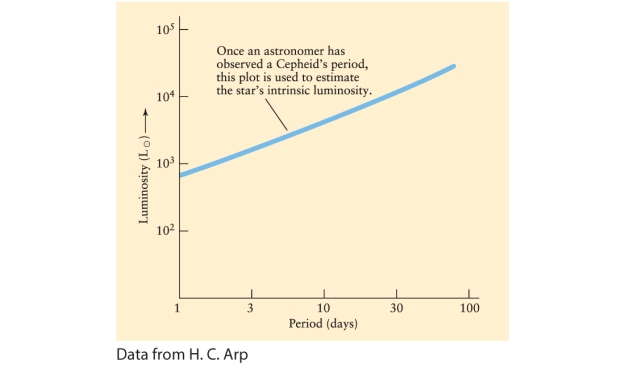
A)3.1 × 104 pc
B)4.8 × 106 pc
C)6.0 × 107 pc
D)8.7 × 109 pc

A)3.1 × 104 pc
B)4.8 × 106 pc
C)6.0 × 107 pc
D)8.7 × 109 pc

Unlock Deck
Unlock for access to all 64 flashcards in this deck.
Unlock Deck
k this deck
61
In a semidetached binary star system:
A)the stars share the same outer atmosphere, but the cores of the two stars do not touch.
B)one star fills its Roche lobe, while the other does not.
C)one star orbits the center of mass, while the other moves freely through space.
D)both stars fill their Roche lobes.
A)the stars share the same outer atmosphere, but the cores of the two stars do not touch.
B)one star fills its Roche lobe, while the other does not.
C)one star orbits the center of mass, while the other moves freely through space.
D)both stars fill their Roche lobes.

Unlock Deck
Unlock for access to all 64 flashcards in this deck.
Unlock Deck
k this deck
62
In a binary system, the first star to fill its Roche lobe is usually a red giant. What can we say about the nature of the other star when this happens?
A)There is no correlation between the two stars, so the second star may be at any stage of evolution.
B)The two stars in a binary system must have the same mass, so the second star must be a red giant at this time also.
C)The two stars in a binary system are formed at the same time, so the other star must be a main-sequence star.
D)The two stars in a binary system are formed at the same time, so the other star is most likely still a protostar.
A)There is no correlation between the two stars, so the second star may be at any stage of evolution.
B)The two stars in a binary system must have the same mass, so the second star must be a red giant at this time also.
C)The two stars in a binary system are formed at the same time, so the other star must be a main-sequence star.
D)The two stars in a binary system are formed at the same time, so the other star is most likely still a protostar.

Unlock Deck
Unlock for access to all 64 flashcards in this deck.
Unlock Deck
k this deck
63
In some binary star systems, such as (Beta) Lyrae, very little light is seen from the more massive star. This is because the:
A)more massive star is still hidden in the dust clouds from which it formed.
B)more massive star is a black hole, from which light cannot escape.
C)more massive star is hidden by an accretion disk of material from the less massive star.
D)orbit of the more massive star keeps it hidden behind the larger but less massive star as seen from Earth.
A)more massive star is still hidden in the dust clouds from which it formed.
B)more massive star is a black hole, from which light cannot escape.
C)more massive star is hidden by an accretion disk of material from the less massive star.
D)orbit of the more massive star keeps it hidden behind the larger but less massive star as seen from Earth.

Unlock Deck
Unlock for access to all 64 flashcards in this deck.
Unlock Deck
k this deck
64
In the Lyrae system, the more massive star is the dimmer star. How could this be?
A)The more massive star is probably a red giant. As it has expanded, its temperature and luminosity have both decreased, as expected.
B)The more massive star has evolved to become a neutron star with a consequent reduction in luminosity.
C)The more massive star has pulled mass from its companion to form an accretion disk, thus cloaking some of its luminosity and appearing dimmer.
D)The smaller star has pulled some of the bright outer layer off the more massive star, thus increasing its own brightness at the expense of its more massive companion.
A)The more massive star is probably a red giant. As it has expanded, its temperature and luminosity have both decreased, as expected.
B)The more massive star has evolved to become a neutron star with a consequent reduction in luminosity.
C)The more massive star has pulled mass from its companion to form an accretion disk, thus cloaking some of its luminosity and appearing dimmer.
D)The smaller star has pulled some of the bright outer layer off the more massive star, thus increasing its own brightness at the expense of its more massive companion.

Unlock Deck
Unlock for access to all 64 flashcards in this deck.
Unlock Deck
k this deck



